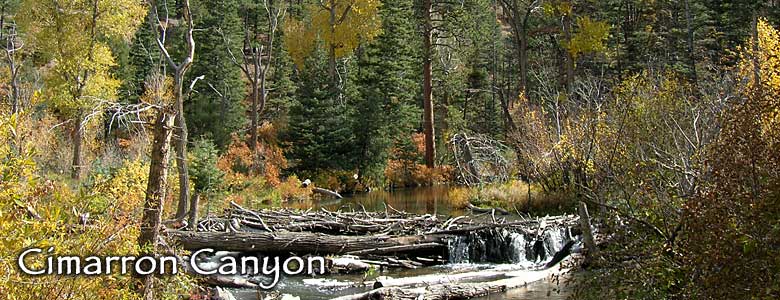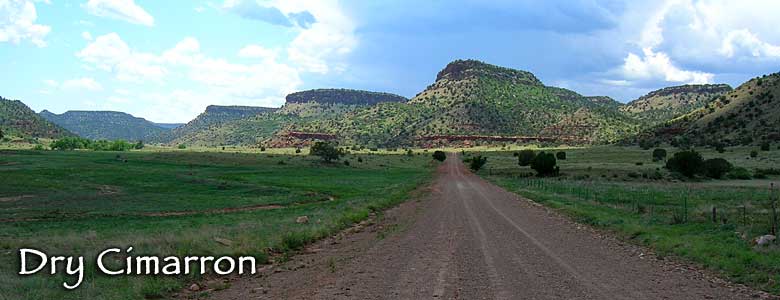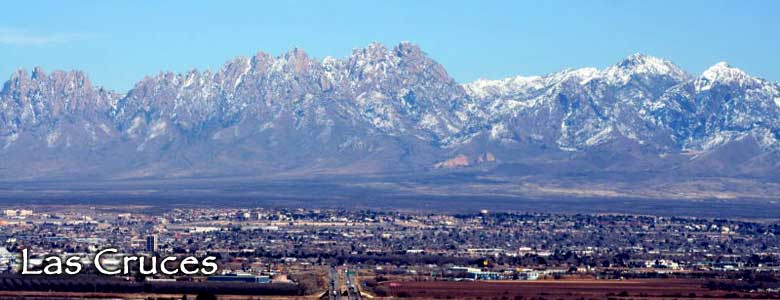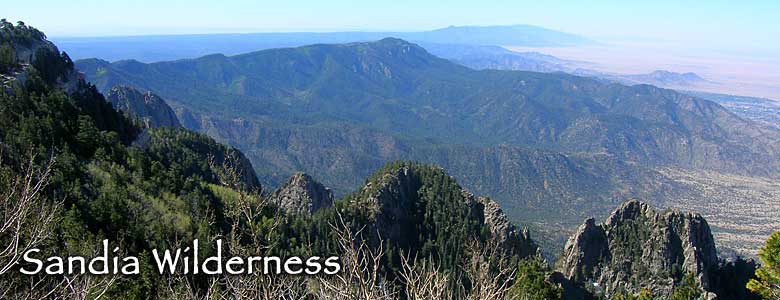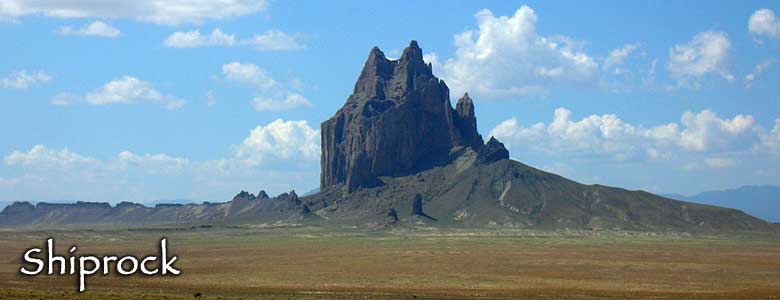
New Mexico Information, Photos and Maps
A Reference and Travel Guide Full of Area Information
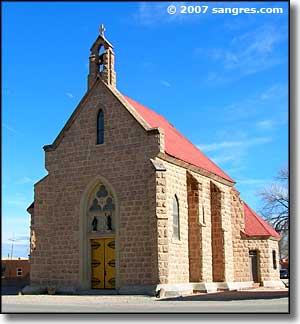
New Mexico: the name alone evokes images of ancient traditions, Native American pueblos, incredibly colorful scenery, huge open vistas, wild geology, and Conquistadors. Chaco Canyon, Taos Pueblo, El Camino Real, Francisco de Coronado, the Seven Cities of Cibola, La Villa Real de la Santa Fe de St. Francis de Assissi, Carlsbad Caverns, White Sands, the Trinity site, Roswell, Los Alamos, Alamogordo, Albuquerque, Billy the Kid, Pat Garrett, the Santa Fe Ring... we all know these names. They're recognized all over the world.
The Spanish were recording history here before the Anglos who landed at Jamestown even loaded up their boat to head over. For that matter, the first true American Revolutionary War was fought (and won) in northern New Mexico in 1680, about the same time William Penn and his Quaker compatriots were first arriving in Pennsylvania. So when you're reading your "American History" book in school and you see hardly a word about this, remember: history is written by the conquerors.
That's what makes it so hard to get a true history of the expansion and migrations of the Europeans in the New World. The Spanish controlled everything in the Southwest until the Mexican Revolution was won (sort of) in 1821. Then the rules started to change.
After 1821, Anglo-Europeans from the United States were allowed to travel to and do business in Nuevo Mexico. That was when trade really blossomed, with the opening of the Santa Fe Trail. With trade came the mountain men and fur trappers, the adventurers and gamblers. The Spanish previously had been adventurers and explorers but they weren't the "sit in the saloon drinking and play cards" types. Those folks moved in from the US. The Spanish did, though, run a slave market of sorts in Taos and that business flourished until just after the American military invasion. But the slaves for sale were not Africans or African-Americans, they were Native Americans from tribes the Spanish had not made peace with...
Gambling, or at least card games, flourished in New Mexico until about the same time Nevada made all games of chance fully legal. Then came a wave across many states banning the practice. For the most part, all gaming was over in New Mexico by the early 1950's, although certain pockets of resistance remained into the late 1960's. Then came the 1990's and the Native American Nations decided it was time to deal with their unemployment and chronic under-funding problems by building and operating casinos. Today, there are New Mexico Casinos on almost every reservation. The state legislature was also anti-lottery for a long time but that was finally approved statewide in the early 1990's (when it became really obvious New Mexico needed the money and could no longer afford to see it "leaking" to surrounding states where government-run lotteries were legal). If you want to see musical acts, theater productions, comedy shows these days... you're most likely to find it at the local Indian reservation casino...
In 1846, after years of manipulations by the "citizens" of the Republic of Texas, the United States Government trumped up a few charges and declared war on Mexico. Stephen Watts Kearny and the Army of the West had been camped out at Bent's Fort for a while (appropriating weapons, supplies and housing, over-grazing all the nearby land, killing all the buffalo they could find and generally harassing anyone and everyone who came to do business with Bent, St. Vrain and Co.) As soon as word came that war had been declared, Kearny and gang (the Mormon Battalion, too) crossed the Arkansas River and marched almost straight through to Santa Fe (over the Mountain Branch of the Santa Fe Trail: past present-day Trinidad and over Raton Pass), taking the Territorial Government of Nuevo Mexico essentially by surprise. The fighting was over in 1847 and the whole affair was concluded with the Treaty of Guadalupe Hidalgo in 1848. Then the rules changed again.
In that treaty, the United States Government guaranteed that the Mexican-government-recorded land claims of the Hispanic settlers in the territories ceded to the United States would be honored. In many, many cases, just like most of the treaties the US Government signed with many Native American tribes, the guarantees written into Guadalupe Hidalgo were little more than bold-faced lies. There are actually quite a few recorded instances where politically connected Americans used the American Territorial Legislatures and Judiciaries to overturn the property provisions written into Guadalupe Hidalgo so that they could dispossess Hispanic settlers from property their families had owned and lived on for almost 200 years. For that matter, some of the early American Territorial Governors in Santa Fe (and their cronies) used the actual recorded Spanish and Mexican title deeds to light their cigars and fireplaces with.

The National Radio Astronomy Observatory's Very Large Array (VLA) on the Plains of San Augustin
The Spanish and Mexican settlers and the Native American tribes must have seen this coming. One of Kearny's first actions had been to appoint Charles Bent Territorial Governor and charge him with declaring and enforcing a new set of laws for New Mexico (the so-called "Kearny Code"). Around New Year's, 1847, the Americans heard rumors of an impending coup so they arrested several of the suspected leaders. It didn't stop the rebellion.
On January 19, 1847, Charles Bent, several other US appointed officials and certain other prominent citizens were killed in Taos and the 1847 Taos Rebellion was on. Dick Green, Charles Bent's black slave, made his way to Santa Fe with some other folks and they told the authorities there what had happened. When the Americans in Santa Fe responded to the threat, Dick returned to Taos with them. They fought a series of battles at Santa Cruz and Embudo, then forced the rebels inside the San Geronimo Church in Taos. The Americans finally broke through after a two-day battle and arrested most of the New Mexicans inside. Over the next few weeks, most of them were hanged for murder and treason. As a result of this, there has never been a peace treaty signed with the natives of Taos Pueblo: technically, they are still at war with the United States Government. When Dick Green returned to Bent's Fort and told William Bent what had happened to his brother, William set Dick and his family free.
Another casualty of the Taos Rebellion was Narcisio Beaubien, Charles Beaubien's son. With his death, Charles made his son-in-law, Lucien Maxwell, heir to the Beaubien part of the Beaubien-Miranda Land Grant. When Charles died and Lucien inherited, he bought out the rest of the family and became sole owner of the Maxwell Land Grant, more than 1,900,000 acres of some of the most beautiful real estate on Earth. Shortly after that, Maxwell sold the land grant to a consortium of English and Dutch investors and in 1868 he bought Fort Sumner and Bosque Redondo, the site of the disastrous (and failed) Navajo relocation in eastern New Mexico. He died there in 1875 and was buried in the post cemetery. In 1881, Pat Garrett snuck his way into a house at Fort Sumner and shot and killed William "Billy the Kid" Bonney in the dark. A couple days later, the townsfolk buried Billy the Kid in the same cemetery, just a few yards from Lucien Maxwell's grave.
You can see from this little bit of rambling on my part that there is some interesting history hiding out in New Mexico, never mind how gorgeous the countryside is. The folks have some great stories of their own, that's part of the enchantment...
NOTE: On many of the pages linked below I try to provide some demographic information. As this information comes from the US Census Bureau, there are a couple of caveats that have to be taken into consideration:
- This information cannot be any more accurate than what the Census Bureau itself offers, and some of the numbers are estimates.
- The "resident racial breakdown" numbers usually don't add up to 100% because Hispanics are often counted among all the other races.
- After the economic meltdown of 2008, the median incomes and median home values are liable to be radically different in 2012.
- The median home values include every type of construction that people live in: townhomes, condos, four-plexes, detached homes, mobile homes, etc.
- The unemployment numbers are a snapshot in time, and most likely have little bearing on what's actually happening in 2012.
Population Demographics: 2010
| Total Population | 2,059,179 |
| Males | 1,017,421 |
| Females | 1,041,758 |
| Population by Age | |
| Under 18 | 518,672 |
| 18 & over | 1,540,507 |
| 20-24 | 142,370 |
| 25-34 | 267,245 |
| 35-49 | 393,362 |
| 50-64 | 404,106 |
| 65 & over | 272,255 |
| Population by Ethnicity | |
| Hispanic or Latino | 953,403 |
| Non Hispanic or Latino | 1,105,776 |
| Population by Race | |
| White | 1,407,876 |
| African-American | 42,550 |
| Asian | 28,208 |
| Native American | 193,222 |
| Hawaiian or Pacific Islander | 1,810 |
| Other | 308,503 |
| Two or more | 77,010 |
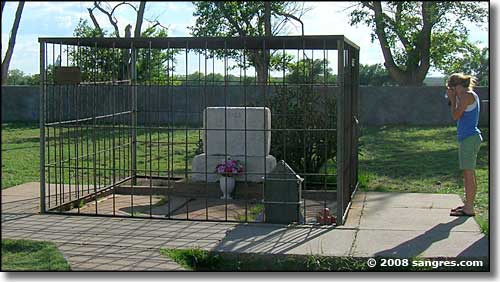
Billy the Kid's Grave (it had to be caged because the tombstone kept wandering away)
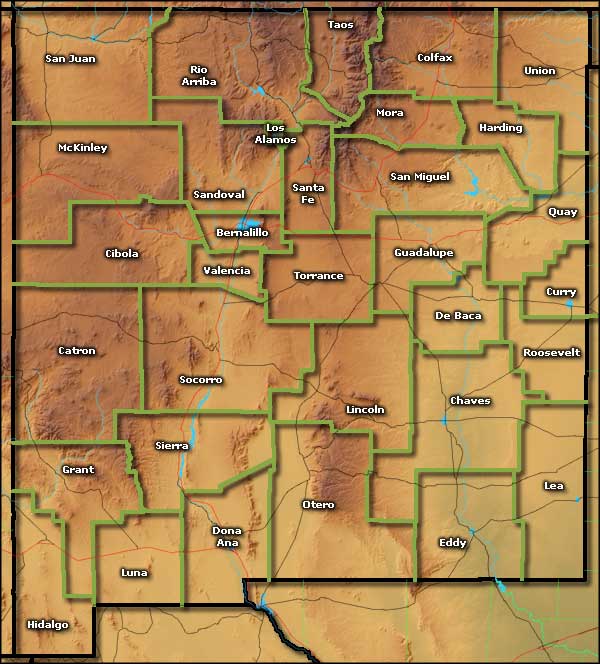
Clicking on one of the county names above will take you to that part of Sangres.com. These county pages have demographic info (population and growth stats), miscellaneous info about the county and access to a zoomable/pannable map centered on the county.
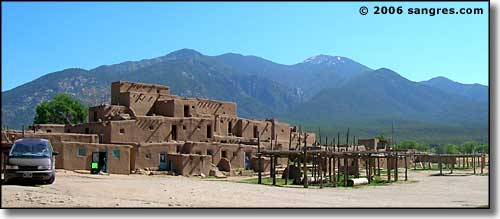
Taos Pueblo, a World Heritage site in northern New Mexico
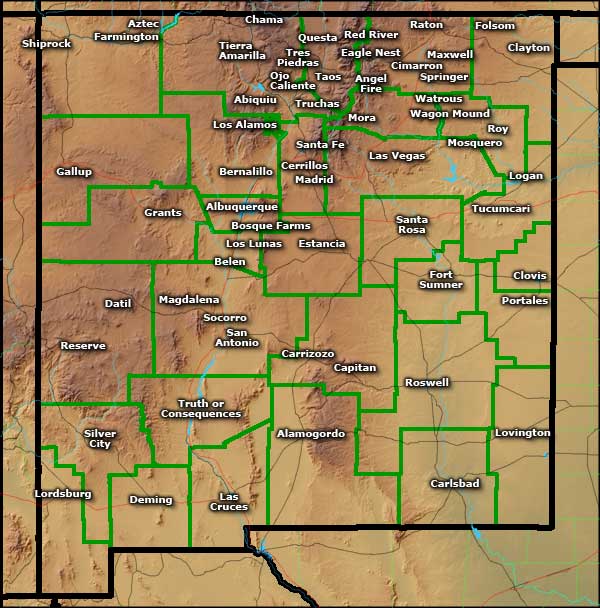
Clicking on an active name on the map above will take you to more info about that place.
Or you can use the list below (not every name below is on the map):

